|
Arms are usually the first noticed and the most respected aspect of the
physique. Not only do they project power,but they define the
remainder of your physique. When training arms, it is must that you progressively increase the poundage, intensitiy, and variety of
exercises. More sets is not always better, but more intensity is. The three most
basic and effective exercises are the standing and seated alternating
dumbell curls and the standing cambered-bar curl (straight bar).
|
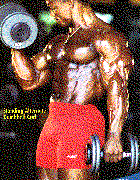 The standing alternating is
great warmup exercise and a major MASS BUILDER. At the start of the rep,
with the palm facing the outer thigh, as the curl begins, twist the wrist
upward. At the end of the rep, squeeze the bicep (flex) for a peak contraction.
On the decent, resist the weight. Try to do 4 sets with about 8-12 reps per set.
Try to get at least eight reps per set, if not, try decreasing your weight for
the proceeding sets. Try not to get more than 12 per set, if you do, try
increasing your weight until the 8-12 range is achieved. The standing alternating is
great warmup exercise and a major MASS BUILDER. At the start of the rep,
with the palm facing the outer thigh, as the curl begins, twist the wrist
upward. At the end of the rep, squeeze the bicep (flex) for a peak contraction.
On the decent, resist the weight. Try to do 4 sets with about 8-12 reps per set.
Try to get at least eight reps per set, if not, try decreasing your weight for
the proceeding sets. Try not to get more than 12 per set, if you do, try
increasing your weight until the 8-12 range is achieved.
Try not to swing the weights, instead, you can apply lots of power to the
upper half of the curl by "tucking" your body under slightly to get more of a
press and squeeze on the heaviest sets. This is one advantage of the standing
position. Always remember that this exercise demands intense concentration on
the contraction of each arm in order to receive maximum effectiveness.
|
|
 The seated alternating curl
have the same effect as standing curls, except that they provide more muscle
isolation. With these, you cant use body language to help power the weight up.
Seated curls also demand more mental effort, because of the concentrated nature
of the movenment. Still, the same rules apply: Squeeze up, supinate as you go,
then resist strongly on the return to avoid letting your body rock and forth.
With these, also try to do 4 sets with 8-12 reps for the first 2 sets then for
the last 2 sets, if necessary, change weights so on the last 2 sets, 10 and 8
reps can be achieved respectively. The seated alternating curl
have the same effect as standing curls, except that they provide more muscle
isolation. With these, you cant use body language to help power the weight up.
Seated curls also demand more mental effort, because of the concentrated nature
of the movenment. Still, the same rules apply: Squeeze up, supinate as you go,
then resist strongly on the return to avoid letting your body rock and forth.
With these, also try to do 4 sets with 8-12 reps for the first 2 sets then for
the last 2 sets, if necessary, change weights so on the last 2 sets, 10 and 8
reps can be achieved respectively.
Again, try not to swing the weights. One option to consider is using a bench
with a back support to minimize the chances of swinging the weights. Remember
that this exercise also demands intense concentration on the contraction of each
arm in order to receive maximum effectiveness.
|
|
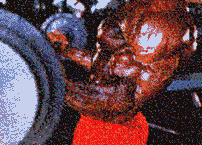 The cambered-bar curl is
particularly useful as a MASS BUILDER and also it alleviates a lot of
adverse torque on the wrists. You can do this exercise alone but it is
considerably more effective when being performed with a partner. The exercise
described is call "BUILDUPS". These are performed with 2 people standing in
front of each other with a selected weight than can be handled by both trainers.
The goal is to pyramid 7 reps. For example, You pick up the weights and complete
ONE rep. Pass the weight to your partner and they too shall perform ONE rep. The
weight is then returned to the first partner to complete TWO reps. The weight is
then given back to the second partner again and they will complete TWO reps.
Then pass the weight back so the first can complete THREE reps. ETC....... This
procedure will continue until seven reps is completed by both parties. After
seven reps is completed, repeat the seventh rep, then work your way back down.
6,5,4, etc... This exercise may sound very simple but once you try it I'm
positive you will have a change of heart. If you perform these toward the
end of your arm workout, you can guarntee that these will force you to bring the
days training to an end. The cambered-bar curl is
particularly useful as a MASS BUILDER and also it alleviates a lot of
adverse torque on the wrists. You can do this exercise alone but it is
considerably more effective when being performed with a partner. The exercise
described is call "BUILDUPS". These are performed with 2 people standing in
front of each other with a selected weight than can be handled by both trainers.
The goal is to pyramid 7 reps. For example, You pick up the weights and complete
ONE rep. Pass the weight to your partner and they too shall perform ONE rep. The
weight is then returned to the first partner to complete TWO reps. The weight is
then given back to the second partner again and they will complete TWO reps.
Then pass the weight back so the first can complete THREE reps. ETC....... This
procedure will continue until seven reps is completed by both parties. After
seven reps is completed, repeat the seventh rep, then work your way back down.
6,5,4, etc... This exercise may sound very simple but once you try it I'm
positive you will have a change of heart. If you perform these toward the
end of your arm workout, you can guarntee that these will force you to bring the
days training to an end.
I hope these techniques will aid in improving your overall arm development
and strength. Performed correctly, they will.
|
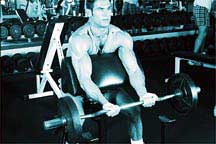

|
Bar
Curls
This
is the true arm mass builder. As you pull the bar upward concentrate on
your biceps muscle. As you approach the top of the movement squeeze the
biceps as you bring the bar under your chin, be careful you i-nay cause
the muscle to craiiij) front tile intense contractions.
* Muscle Confusion Tipv: Use a straight bar for one workout and an
angled curling bar on the next workout. Vary the width of your grip from
your hands being next to each other, or as much as 30 inches apart. Try
pausing half way down or halfway up to really feel your arms burn. Half
reps are an awesome way to vary your routine. These can be done from the
first half of the inovement or from the back half of the movement. Try
bringing the bar halfway up pause and return, on your next workout try the
opposite by lowering the bar halfway down, pausing and return to the
top. <<Preacher Curls
Preacher curls really pump up the peak of the
biceps, because they force you to perfori-n the movement using only the
biceps muscle. As with "Bar Curls" there are many ways to vary the
movement to promote muscle confusion.
* Muscle Conlitsion Tips: Use a straight bar for one workout and an
angled curling bar on the next workout. Vary the width of your grip from
your hands being next to each other, or as much as 24 inches apart. Try
pausing half way down or halfway up to really feel your arms bum. Half
reps are an awesome way to vary your routine. These can be done from the
first half of the movement or from the back half of the movement. Try
bringing the bar halfway up pause and return, on your next workout try the
opposite by lowering the bar halfway down, pausing and return to the
top. |
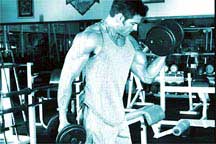

|
Dumbell Alternate Curls
This
exercise can be done from a standing or seated position. Keep your elbows
at your side, and your palms facing upward as you lift the dumbbell. Since
you are alternating your arms you should be able to really focus on the
bicep that is moving the weight.
* Muscle Conrfusion Tips: Keep your palms upward on one
workout, they
try them inward (facing each other) with heaveier weight. You can also use
a slight cheating motion and use heavier dumbbells - as you lower the
weight be sure to keep the dumbbell under control and conventrate on
feeling the negative burn. |


|
High Cable Cross Cable Curles
Perfon-n this movement as if you are doing
the classic double biceps pose. Stretch out as far as you can and pull the
handles toward your ears. Concentrate on feeling the biceps flex as you
perform the movement. Notice that T.J.'s elbow position remains perfectly
stillfrom the start to finish.
* Muscle Confusion Tips: Take a couple steps backward -- lean back
slightly and pull the handles towards your ears. You can also use a lower
pulley and curt the handles towards your shoulders. |
 |
Sweat Those Biceps!
Each set consists of eight repetitions. To warm
up: Do a set at fifty percent of your maximum effort. Begin with three sets of
eight. When you can't break a sweat with that, add five more reps to each set.
Standing barbell curl.
With your elbows against your sides throughout the motion, grip the barbell and
curl it toward your shoulders.
|
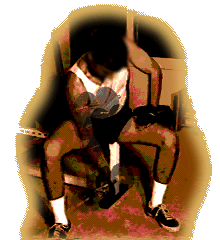 |
Concentration curl.
Sit on the edge of an exercise bench with your knees slightly more than
shoulder-width apart. Grasp a dumbbell with your right hand and place your upper
arm against your inner right thigh. Resting your left hand on your left thigh
for support, curl the dumbbell up and toward your shoulder. Do eight, then
switch arms.
|
| |
Reverse grip barbell curl.
Hold a barbell with your hands shoulder-width apart and your palms facing your
body. Slowly curl the barbell toward your shoulders. Keep your elbows against
your sides throughout the movement. No barbells? No problem. You can also use
dumbbells.
Dumbbell preacher curl.
Sit at a preacher curl station. Rest your upper arms on the pad. Palms up! Curl
the dumbbells to your shoulders. Pray. Repeat.
|
 |
Standing Biceps
Curls
Yep, the beginner's standard for building overall
biceps mass is still the first exercise in Brantley's routine. He'll do a couple
of warm-up sets in a controlled manner, paying attention to strict form --- no
rocking, bringing the bar up evenly in about a second, pausing for a second at
full contraction, and then lowering the bar in two to three seconds, pausing
again for a second, and starting again.
Look closely and see that Sean does not let the bar extend fully
when he lets it down. "No matter what the exercise, it almost always needs to
provide constant tension. If I let the bar extend until my elbows were fully
locked out, all I would have accomplished would be to let my biceps rest. If the
type of heavy weight I use is going to work, then I have to make sure I work it
fully and hard, which means paying attention to what I'm doing at each moment,
and not letting the weight rest." The exercise is simple. Take a long
straight barbell and grasp it at about shoulder width. Pull the weight up in a
smooth and controlled manner until it comes to your chest --- making sure that
it doesn't rest against your chest at full contraction either --- and then let
the weight down in about two seconds, making sure you do not let your elbows
lock out. And keep your elbows in to your sides, so that your biceps, and not
nearby muscles, do the work. The elbows should not come up as you conclude the
contraction, either, because that places the forearms in a nearly straight-up
position and takes tension off the biceps.
|
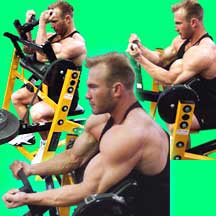 |
Seated Incline Cammed
Machine Curls
It's a testament to Sean's concentration
abilities that he remains focused and keeps his eyes straight ahead, even as
Missy spots him. Like most biceps exercises done with machines or straight bars,
this exercise is fairly simple: Find a seat position that allows you sit with
your body slightly forward and your arms well ahead of you, while lining up your
elbows with the pivot of the machine bar. Use the same protocol and counts as in
the standing barbell curls. You'll find a significantly different effect than in
the first exercise, for three reasons: 1) Your arms are well in front of your
body, due to the machine's construction, and work the biceps from a different
and isolated angle; 2) The handle grip is angled and fairly close-grip,
providing another angle of biceps attack; 3) The weights are attached to a cam,
which keeps the effective working weight relatively constant throughout the
movement. (In the standing barbell curls the effective working weight is
significantly less at the beginning and end of the exercise.) |
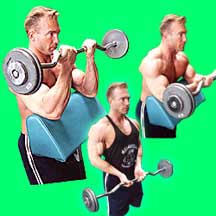 |
Preacher
Curls
This exercise looks almost identical to the
preceding one and is a classic for working the lower portions of the biceps.
Since there's no cam or machine to vary the working load distribution throughout
the movement, the feel and effect of the exercise is quite different, keeping
the muscle confusion technique alive and well. Additionally, there's more room
for grip changes, varying from close to wide. You'll also note --- as we did ---
that Missy is missing. |
 |
Standing Concentration
Curls
Concentration curls work to create biceps height.
While many bodybuilders do this exercise seated, Sean prefers to stand up. He
begins with the dumbbells near his side, just slightly in front of his body (so
he can bring them up), with a palms-in grip. He alternates the dumbbells,
bringing them up past 90 degrees to a full biceps contraction. |
 |
Cross Cable
Curls
For most bodybuilders, this is considered a
finishing or shaping exercise, meaning that the weight is taken down to a level
which allows higher rep ranges. Not for Brantley, however, who pushes the weight
up for that four- to-seven rep range he prefers. Stand with your body midpoint
between the two towers which house the cables and with your shoulders lined up
with the cables so that your arms do not have to pull either from the front or
rear, but directly from the sides. Grasp the horseshoe attachments and pull
evenly until your biceps fully contract. Then slowly allow the weight to pull
your arms out to almost full extension...if they fully extend you've removed
tension from them and have probably performed a nice shoulder and biceps
stretch; not a bad thing, but not the type of concentration you'll need to grow
into a Sean clone. |
| |
One Arm Low Cable
Curls
Sean does this both facing the machine and, as
shown here, facing away from it. In either case he makes sure that his body does
not lean or sway during the movement, which is simple and straightforward: Grasp
the horseshoe handle and pull the weight up until your biceps contracts fully.
Pause for a second and lower the weight, allowing your arm to almost fully
extend (that essential constant tension again!). You can alter the working
angles and emphasis on the areas of the biceps by changing the orientation of
the grip: Sean begins with a palms-up grip and keeps it fairly constant
throughout the movement. But you can begin with a palms-in grip and change it at
the conclusion of the movement, turning it into a sort of machine cable
concentration curl. |
Sets &
Reps
Like the vast majority of advanced bodybuilders,
Sean Brantley's biceps routine bears very little resemblance to the workouts
suggested in instructional texts: He does single sets of most exercises, rather
than multiple sets. And he pushes hard. Very hard. "My reps usually fall in the
four to seven reps range for my biceps work," says Sean, "but sometimes they'll
go even lower than that. I tend to stay at this rep range right until contest
time, letting my dieting and some cardio do the cutting. But, having worked out
for a loooong time, my training routine is almost entirely instinctual at this
point. If, at the end of my routine, I can't see and feel the pump, then I make
adjustments." Sean laughs: "That adjustment usually means I need to add more
weight." Ouch! For a more complete treatment of sets and reps, check out
the Max
Muscle workout guide available FREE by CLICKING HERE.
Adapting This Routine For
Beginners.
Beginners with less than 18 months of
continual workouts should restrict the biceps segment of their overall routine
to no more than three sets of two exercises, for a maximum total of six sets.
The standing barbell curls, done with weight that allows you to reach between 10
and 12 reps, should develop good overall area size. If you're at least eight
months into working out, you can try pyramiding: Use a weight that lets you
perform 12 reps in the first set, 10 in the second, 8 in the third, and 6 in the
fourth. (You may find that your reps don't match that exactly, and that's okay.
But if you fall below 6 in the fourth set, try lowering the weight a little.)
The cable curls, done in the same set and rep scheme, provide some finish and
shaping. If you are a hard gainer, try upping the weight in these as well.
Intermediates
If you've got a solid 18
months under your belt, the usual reasoning would be to have you select two mass
movements --- heavy work like standing biceps curls and machine curls or seated
dumbbell curls --- and one or possibly two finishing or shaping movements. If
you're working for more size, keep the weight up and the reps low, from five to
eight tough, heavy reps per set, and don't go above 8 sets, total, for this
bodypart. |
| Biceps
This muscle ranks right up there with chest for
popularity.
There is nothing too revolutionary to say about biceps training. Stretch them
good with an exercise like incline curls or using a preacher bench, use a lot of
weight with barbell curls, and give them a good, focused workout with
concentration curls or alternating dumbell curls (seated), and you should have
no problems with biceps development.
Please realize that it would be a
lot more difficult to increase biceps size without increasing the rest of you
muscle mass. Or stated differently, it would be easier to put an inch on your
arms if you gained 10 pounds of muscle on your entire body. In fact, if you
stick more with compound exercises like chin-ups, deadlifts and squats, your
arms will undergo a great deal of development as well. Besides, having larger
shoulders makes your arms look bigger anyhow, just like bigger calves make your
quads look bigger.
Since the arms are a small muscle group, you can work
them out more often than larger muscles like legs and back, but I would
definitely focus my energy on the larger bodyparts, especially for the first
year of bodybuilding.
|
 |
Barbell curl
Touted as the mass builder of all biceps
exercises,
probably cause it lets you handle a lot of weight, and is a relatively
compound exercise as far as biceps go. Stand with feet shoulder width
apart, grab the bar with roughly shoulder width grip, maybe a bit less or
more, keep your elbows at your sides and live in a smooth motion. Lower
bar in a controlled motion. Pretty straight forward, meat-and-potatoes
type of exercise. |
| |
Pretty much the same
as above, though you may find you'll need a wider grip, grab the bar with palms
down/facing you. This works the brachialis and forearms more, just thought I'd
mention it here.
|
| |
Lying on an incline
bench, let your arms hang down at your sides, palms facing back. As you lift the
weight, rotate your hands so your palms are rotated 180 degrees (facing your
face at top of lift). This is a great full range of motion exercise, and gives a
good stretch. I prefer doing one arm at a time.
|
| |
Sitting on a
bench, arms hanging at your sides, lift one dumbell through a complete rep, then
lift the other. This is my favorite, as it lets me focus on each arm separately,
and handle more weight. Try to keep your elbows at your side, and torso steady.
|
| |
Be prepared to lower
your weight if your gonna do this exercise. Either sit on a bench, or bend over
and lean against something (knees bent) as you curl one arm at a time. Twist
your wrist so your pinkie is closest to your shoulder at the top of the lift.
This exercise is said to work the outer head of the biceps and really develop a
good peak.
|
| |
Preacher curlsThis is another great
exercise for full range of motion, with a good stretch. Take the time to adjust
the seat/chest pad for greatest comfort. You don't want to be hunched over the
pad, and you want your elbows to rest on the pad fairly easily. Spotters are
highly recommended on this exercise! Also a great exercise because it basically
prevents any cheating!
|
Sample routine for bicepsIn all honesty,
I don't work my biceps all that much. I usually let my chinups comprise the
whole of my biceps workout, though I am starting to get into it again. When I do
get around to working biceps, it usually looks something like this:
- 3-4 warm-up sets of 8,6,4,2 reps, rest 2-3 minutes
- 3 heavy barbell sets of 8-10 reps
- 2-3 seated alternating dumbell curls, 6-10 reps
- 2 reverse curls, 10-12 reps
for a better stretch you might
consider:
- 3-4 warm-up sets of 8,6,4,2 reps, rest 2-3 minutes
- 3 sets of preacher bench, 10,8,6 reps
- 3 sets of alternating incline curls, 6-10 reps.
|

 |
STANDING HAMMER CURLS
There are two important points to remember when
performing these exercises: The first is to avoid cheating at all times.
Cheating on curls is especially common, particularly when the muscles tire
toward the end of the workout. Bending forward at the waist, whipping the torso
back and throwing the weight up increases the risk of back injury and defeats
the purpose of the exercise. Two simple suggestions for preventing this are to
lift less weight and make minor modifications to your stance. Keep your feet
shoulder-width apart and moving one foot slightly in front of other will reduce
the chance of injury, limit your ability to cheat and promote the correct range
of motion.
Rest interval are the other important thing to
bear in mind. The less time you take between sets, the more stress is allotted
to your body and the more your muscles will respond. In the beginning stages of
this workout, your rest time between sets should be no longer than two minutes.
A maximum of five minutes rest should be taken between exercises. As you become
more accustomed to the workouts, reduce the time between sets to one minute and
the rest intervals between exercises to three minutes.
Grasp a dumbbell in each hand and stand
erect with your feet shoulder width apart. Position the arms down at the sides
of your body with the palms facing in toward your legs. Lift your right arm
upward and forward across your chest until the top of the dumbbell is at
shoulder level. Hold for a second and return to starting position. As the right
arm is being lowered, begin to lift the left arm upward and forward across
the body. Continue alternating both arms. Do four sets of 8 - 10 repetitions for
each arm.
|
|
 The
The  The
The  The
The 















